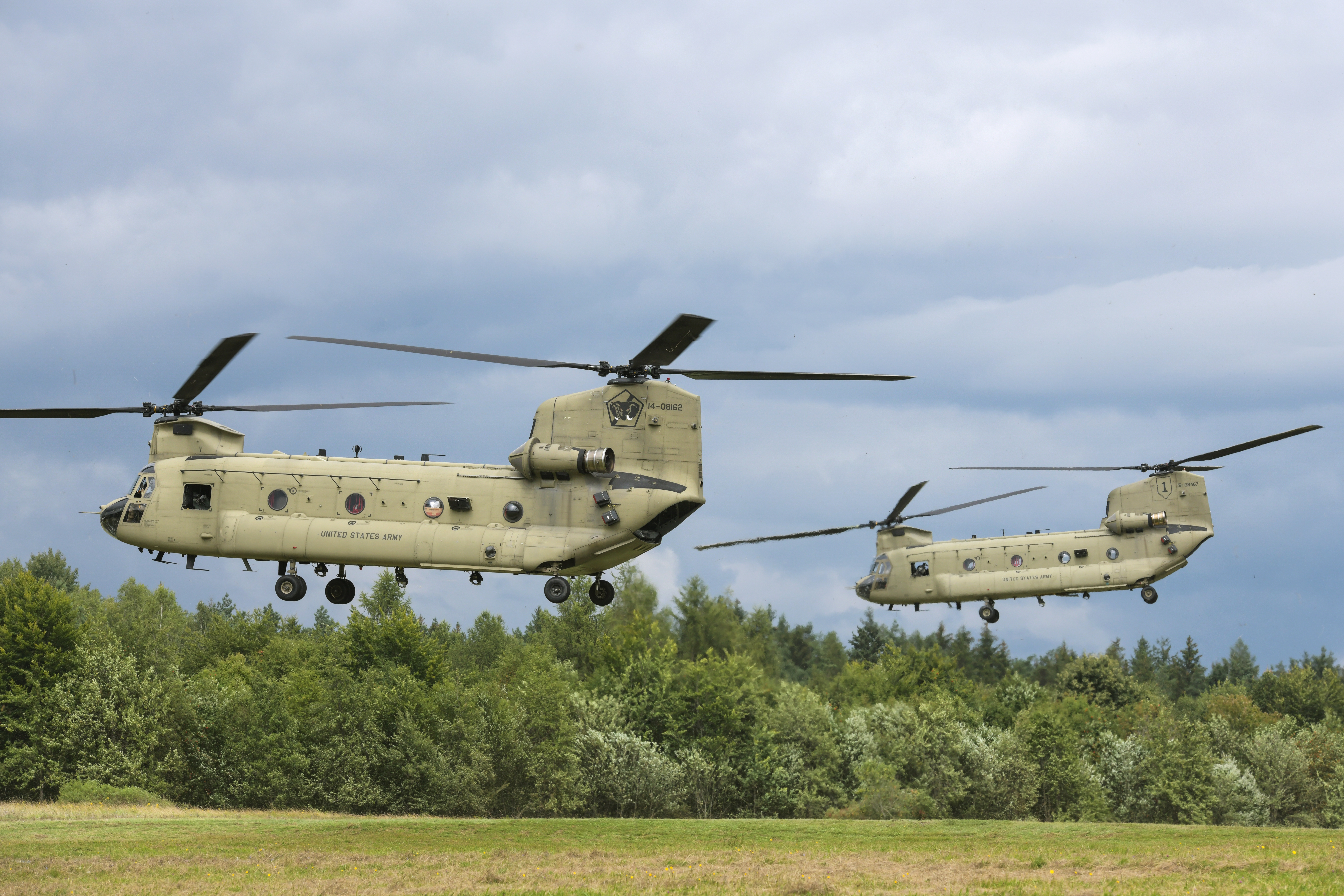The German government will buy Boeing’s CH-47 Chinook to satisfy the need for a modern heavy-lift helicopter, passing on the Sikorsky CH-53K for the “Schwerer Transporthubschrauber,” or Heavy Transport Helicopter program.
Germany plans to purchase 60 F-model Chinooks in the Block II standard configuration with air-to-air refueling capability, Defense Minister Christine Lambrecht announced on June 1 “after careful consideration of all factors.” Block II includes a toughened airframe, improved drivetrain and avionics upgrades to the CH-47F Block I. As the incumbent heavy-lift helicopter builder for Germany, the competition was Sikorsy’s to lose, as the German armed forces have flown the CH-53G Super Stallions since the 1960s.
“We thoroughly weighed up the pros and cons, as well as the risks — and then came to a unanimous decision in favor of this model.,” Lambrecht said. “The Chinook is modern and proven. With this model, we are strengthening our cooperation capability in Europe. In addition, we get a larger fleet here and gain flexibility.”
There is no official letter of agreement yet, according to a Boeing spokesperson. Germany’s parliament must still approve the decision to enter a U.S. Foreign Military Sales (FMS) program to replace its current fleet of Sikorsky CH-53G helicopters.

“Boeing is honored the German government has selected the CH-47F Chinook for its future heavy-lift helicopter requirements,” the spokesperson said in an email. “We look forward to working with the U.S. and German governments to finalize this sale under the Foreign Military Sales process.” Together with our Chinook Deutschland Industry Team … we are committed to delivering maximum operational availability to the German Bundeswehr for decades to come.”
Sikorsky, now owned by Lockheed Martin, said it was “disappointed” by the decision and was awaiting a debrief from the German Ministry of Defense. As builder of the in-service CH-53G, the company said it is committed to the “long-standing relationships supporting the German Armed Forces.”
“We remain confident the Sikorsky CH-53K King Stallion is the safest, most modern, capable, and reliable heavy-lift helicopter available today,” a Lockheed spokesperson said in an email to The War Zone. “The CH-53K can provide significantly more advanced operational capabilities, aerial refueling, extended range for humanitarian missions, and unmatched heavy lift capabilities with far fewer aircraft, logistical support, maintenance, training, and operating cost than any heavy-lift aircraft flying today.”
Chinook and the King Stallion have gone head-to-head for the German STH program for several years. Though both are heavy lifters and have radically different designs, Germany wasn’t the first time the CH-47 and CH-53K fought for the same program. In another one-on-one competition to replace Israel’s CH-53 helicopters, the CH-53K triumphed. With a per-unit cost of $32 million, the CH-47F Block II is also far more affordable in terms of initial acquisition compared to the CH-53K, which has a flyaway cost of $91.6 million per aircraft.

The tandem-rotor CH-47 Chinook has been in service with the U.S. Army and allied militaries for decades. In the current F-model configuration, the CH-47 can take off at a gross weight of 46,280 pounds at 4,000 feet on a 95-degree Fahrenheit day. Boeing and the Army are also developing a Block II configuration that features a more robust airframe, souped-up drivetrain, and improved avionics. With new advanced rotor blades, the configuration was meant to boost a Chinook’s takeoff weight to 48,000 lb. in the same conditions. However, the Army has decided not to purchase advanced rotor blades.
F-model Chinooks can carry 36 troops, have an external sling-load capacity of 26,000 pounds using the center hook, and are powered by twin Lycoming T55-GA714A engines, each with 4,733 shaft horsepower. Boeing, in cooperation with the Army, has also flown the CH-47F with more-powerful General Electric T408 engines, the same ones installed on the CH-53K.
The CH-53K is an evolutionary derivative of Germany’s current CH-53G fleet. It is designed for use aboard ships in harsh maritime and coastal environments. The single-main-rotor helicopter only recently entered service with the U.S. Marine Corps after a tumultuous development process filled with growing pains. It will replace the CH-53E in performing heavy ship-to-shore transport of cargo and troops.

Each King Stallion is powered by three 7,500-shaft-horsepower General Electric GE38-1B engines that give the helicopter massive lifting power for a maximum takeoff gross weight of 88,000 pounds. The CH-53K has lifted loads up to 36,000 lb. on an external center hook and can carry 37 troops aside from pilots and crew.
In choosing Chinook, Germany gave up some lifting capacity. Still, it aligned itself with eight other NATO countries — the Netherlands, Italy, Greece, Spain, Turkey, the U.K., Canada, and the United States — that operate some variant of the CH-47.
Initially planned as a direct commercial sale to Germany, Berlin reversed course midway through the original selection process and submitted a request to purchase an STH aircraft through the FMS process, which Lockheed protested last year and lost.
In September 2020, Germany rejected both offers claiming they were too expensive, effectively canceling the program. At the time, the Ministry of Defense acknowledged the need for a new heavy-lift rotorcraft and committed itself to replace the CH-53G in a “timely manner” if a more affordable option became available.
Germany seems to have overcome the budget considerations that caused that cancellation. The STH saga also comes to a close in a very different security environment than what existed in Europe before Russia invaded Ukraine. That conflict has pushed NATO member states to modernize and expand their militaries more aggressively. Though Germany has been slow to provide arms directly to Ukraine in its fight against Russia, moving forward on the STH program broadcasts a desire to bolster Germany’s military and NATO’s collective security. The heavy-lift capabilities these helicopters will provide are a critical component of doing so.
Contact the author: Dan@thewarzone.com
